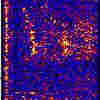Inferred Harmonic Tremor
 Since
May of 1998, both SOSUS and the
Eastern Equatorial Pacific autonomous
hydrophone array have detected extremely loud volcanic
tremor-like signals from the Volcano Island chain south of
Japan. The signals are characterized by a high amplitude fundamental
at around 10 Hz and three harmonics at 20, 30, and 40 Hz.
The tremor signals typically appear as discrete packets that
last for 4-5 minutes, with brief periods of quiescence for
roughly 30 seconds followed by the beginning of the next signal
packet. During the record of each signal packet, the spectral
peaks change frequency (typically increasing by 5-10Hz) as
a function of time while maintaining their harmonic spacing.
These spectral characteristics are very distinctive and have
been previously identified in volcanic tremor recorded using
both seismic and airborne acoustic records at Arenal Volcano
in Costa Rica (Garces et al., 1998) and at Pavlof Volcano,
Alaska (Garces and Hansen, 1998). Unfortunately, the source
of these signals is outside of optimum array coverage, so
the estimated locations are not accurate. The best locations
place it between 22-27N latitude and 138-141E longitude. Since
May of 1998, both SOSUS and the
Eastern Equatorial Pacific autonomous
hydrophone array have detected extremely loud volcanic
tremor-like signals from the Volcano Island chain south of
Japan. The signals are characterized by a high amplitude fundamental
at around 10 Hz and three harmonics at 20, 30, and 40 Hz.
The tremor signals typically appear as discrete packets that
last for 4-5 minutes, with brief periods of quiescence for
roughly 30 seconds followed by the beginning of the next signal
packet. During the record of each signal packet, the spectral
peaks change frequency (typically increasing by 5-10Hz) as
a function of time while maintaining their harmonic spacing.
These spectral characteristics are very distinctive and have
been previously identified in volcanic tremor recorded using
both seismic and airborne acoustic records at Arenal Volcano
in Costa Rica (Garces et al., 1998) and at Pavlof Volcano,
Alaska (Garces and Hansen, 1998). Unfortunately, the source
of these signals is outside of optimum array coverage, so
the estimated locations are not accurate. The best locations
place it between 22-27N latitude and 138-141E longitude.
The tremor
has been occurring intermittently since May 1998, but as of late 1999
was still being recorded. During this time, periods of intense tremor
activity have been recorded on 30 different days. Peak amplitudes and
durations occurred on August 16-18, and 31 in 1998, and on April 22, August
20-27, and October 10-11, 1999. December 10-12, 1999 produced some of
the loudest signals yet detected.
Click on spectrogram for full-sized image.
Listen to the sound, 1.18MB
wav file
(The recorded signal has been sped up 16 times)
|

